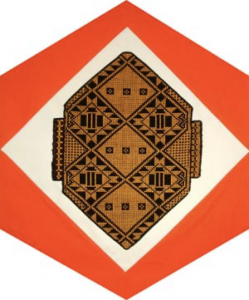Guinea-Bissau

The Block
Guinea-Bissau boasts a strong tradition of weaving and tie-dyeing colourful woven cottons. As the skillful hands of weavers work the narrow strips of cloth, creative, geometric designs begin to emerge, the more intricate of which are used only for special ceremonial clothing. Styles and patterns, which identify specific ethnic groups, may differ throughout the country, but the craft itself is an integral part of the culture that all the tribes share. It is even featured on Guinea-Bissau’s 1000-peso banknote, which shows a man weaving a pano de banda (sash). Men and the older generation of both genders traditionally wear garments with a length of fabric draped over one shoulder. Women often adapt the cloth to make skirts. This block features a wonderful example of Guinean weaving in which the rich gold and black fabric, contributed by Molly Kane, has been creatively folded to highlight its elaborate patterns.
Cultural Profile
Guinea-Bissau, which borders the North Atlantic Ocean, is located in Western Africa between Guinea and Senegal. This relatively small country (less than half the size of New Brunswick) is a low-lying coastal region of swamps, rain forests and mangrove-covered wetlands. It also has more than 20 offshore islands, including the Bijagos archipelago, which extends 48 km out to sea. The land now known as Guinea-Bissau was once the Kingdom of Gabú, a part of the greater Mali Empire. The area later became an overseas province of Portugal and was named Portuguese Guinea. Following a declaration of independence in 1973, the country adopted its current name. Prior to independence, over 95 % of Guinea-Bissau’s population was African, which to this day remains the case. The main tribal groups, each of which has its own distinct language, customs and social structures, are the Balanta, Fula, Manjaca, Mandinga and Papel. Portuguese is the official language, although Criolo and various African tongues spoken as well.
Many Guineans still live in traditional tabancas, or villages, and many are involved in agriculture, which is the backbone of their economy. Cashews––the country’s ‘petroleum’––are the nation’s second largest crop as well as its most important export and 90% of those produced are grown by rural farmers.
The culture of Guinea-Bissau is impacted by the diversity of its ethnic groups, although a passion for eating and dancing are common practices shared by all. Social customs demand that one not pass by a person without acknowledging him, and even strangers are often invited to share a meal. Many facets of cultural life are organized by the government, including a school of music and dance that is maintained by the National Arts Institute. The music of Guinea-Bissau is known for its gumbe style, featuring percussion and airy guitars, with lyrics in Guinea-Bissauan Creole. Carnival, a legacy of the Portuguese, is also celebrated in Guinea-Bissau, even though most Bissau-Guineans are Muslim. The carnival showcases the country’s numerous traditional dances and music, with street parades taking place before the beginning of Lent. It is one of the country’s biggest annual events. Rituals also play an important role in the the country’s daily life. Shrines dedicated to the spirits of ancestors are a common sight and remain places of pilgrimage throughout the country.
Like many African nations, Guineans practice a wide range of traditional handicrafts, including sculpture, pottery and basketry, as well as primitive painting, beautiful examples of which are housed at Bissau’s (the capital city) Museum of African Artifacts. Traditional weaving of the pano, a narrow strip of cloth, continues. These are often joined to make larger garments, their patterns varying from one weaver to another.
People have been coming to Canada from Guinea-Bissau since 1987, bringing with them their characteristic spirit of acceptance, and sharing their cultural heritage through such things as music, dance and cuisine.
Sponsor: Lydia Bryan
